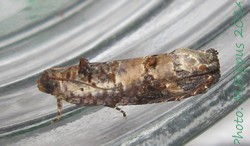
Gnetum is a genus of gymnosperms, the sole genus in the family Gnetaceae within the Gnetophyta. They are tropical evergreen trees, shrubs and lianas. Unlike other gymnosperms, they possess vessel elements in the xylem. Some species have been proposed to have been the first plants to be insect-pollinated as their fossils occur in association with extinct pollinating scorpionflies. Molecular phylogenies based on nuclear and plastid sequences from most of the species indicate hybridization among some of the Southeast Asian species. Fossil-calibrated molecular-clocks suggest that the Gnetum lineages now found in Africa, South America and Southeast Asia are the result of ancient long-distance dispersal across seawater.

Ficus obliqua, commonly known as the small-leaved fig, is a tree in the family Moraceae, native to eastern Australia, New Guinea, eastern Indonesia to Sulawesi and islands in the southwestern Pacific Ocean. Previously known for many years as Ficus eugenioides, it is a banyan of the genus Ficus, which contains around 750 species worldwide in warm climates, including the edible fig. Beginning life as a seedling, which grows on other plants (epiphyte) or on rocks (lithophyte), F. obliqua can grow to 60 m (200 ft) high and nearly as wide with a pale grey buttressed trunk, and glossy green leaves.
Asota orbona is a moth of the family Erebidae first described by Samuel Constantinus Snellen van Vollenhoven in 1863. It is found in Indonesia, Papua New Guinea and Queensland.
Xenothictis is a genus of moths belonging to the subfamily Tortricinae of the family Tortricidae.

Dudua aprobola, the mango flower webworm or litchi leaf roller, is a moth of the family Tortricidae. The species was first described by Edward Meyrick in 1886. It is a pest on several economically important crops.

Homona coffearia, the tea tortrix or camellia tortrix, is a moth of the family Tortricidae. The species was first described by Nietner in 1861. It is widely distributed in the Oriental region.

Glyphodes multilinealis, the fig-tiger-moth, is a species of moth of the family Crambidae described by George Hamilton Kenrick in 1907. It is found in Papua New Guinea, Fiji, Niue, the Cook Islands, the Society Islands, in Australia and Japan.
Nexosa aureola is a species of moth of the family Tortricidae. It is found in New Guinea.
Diakonoffiana tricolorana is a species of moth of the family Tortricidae. It is found in New Caledonia, New Guinea and Australia, where it has been recorded from New South Wales and Queensland.

Bactra optanias is a species of moth of the family Tortricidae first described by Edward Meyrick in 1911. It is found in Papua New Guinea, Australia, New Zealand, Java, Tahiti, Sri Lanka, New Caledonia, the Caroline Islands, the southern Mariana Islands, Rapa Iti and Micronesia.
Xenothictis sympaestra is a species of moth of the family Tortricidae. It is found in New Caledonia in the southwest Pacific Ocean. The habitat consists of rainforests.
Xenothictis oncodes is a species of moth of the family Tortricidae. It is found in New Caledonia in the southwest Pacific Ocean. The habitat consists of rainforests.
Homona trachyptera is a species of moth of the family Tortricidae. It is found in New Guinea, as well as Australia, where it has been recorded from Queensland.
Xenothictis noctiflua is a species of moth of the family Tortricidae. It is found on Vanuatu in the South Pacific Ocean.
Xenothictis paragona is a species of moth of the family Tortricidae. It is found on the Loyalty Islands in the south-west Pacific.
Xenothictis semiota is a species of moth of the family Tortricidae. It is found on the Loyalty Islands in the south-west Pacific Ocean.
Xenothictis sciaphila is a species of moth of the family Tortricidae. It is found in Australia, where it has been recorded from Queensland and New South Wales.
Macaranga novoguineensis is a species of tree in the Euphorbiaceae family. It is native to New Britain and New Guinea. It is a late succession plant, and supports a variety of insect herbivores, including caterpillars from the moth Homona mermerodes.
Ficus bernaysii is a lowland rainforest tree in the family Moraceae, native to an area from New Guinea to the Solomon Islands. It is dioecious, and grows cauliflorous fruit. It is fed on by a wide range of animals.
A tree in the Moraceae family, Ficus phaeosyce grows in eastern New Guinea, endemic to the nation of Papua Niugini. It is a shade tolerant understorey species, locally very abundant. A range of insect herbivores feed on the plant.





